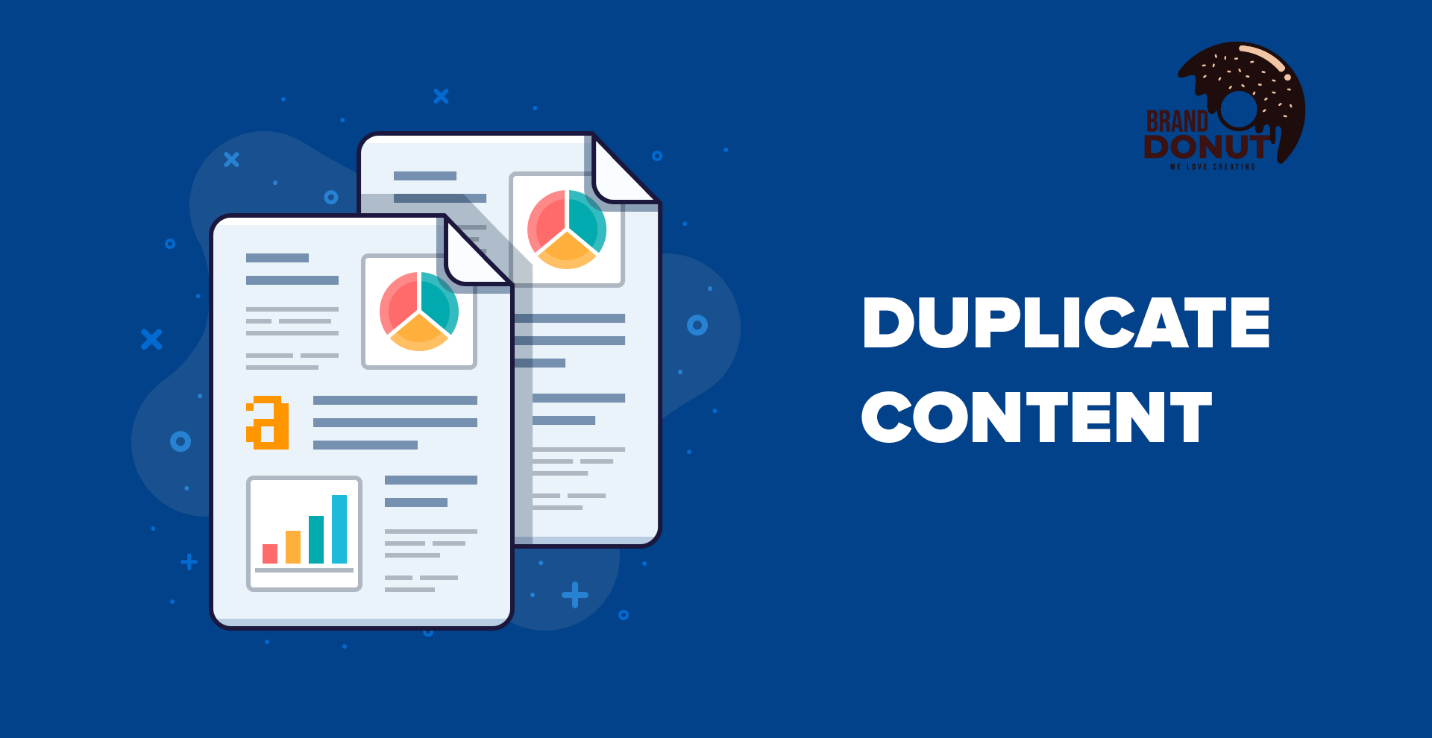Duplicate Content and SEO: The Complete Guide

Duplicate content refers to content that appears online in more than one place. It can be exactly the same content or almost exactly the same, and it can be on the same website or on different websites. Having large amounts of duplicate content on a website can negatively impact rankings in search engines like Google. In this comprehensive guide, we will discuss what duplicate content is, why it’s bad for SEO, what causes it, how to identify it, and how to fix duplicate content issues.
Contents
- 1 What is Duplicate Content?
- 2 Why is Duplicate Content Bad for SEO?
- 3 Myth of the Duplicate Content Penalty
- 4 What Causes Duplicate Content?
- 5 How to Identify Duplicate Content
- 6 How to Deal with Duplicate Content Issues
- 7 Best Practices for Duplicate Content
- 8 Benefits of Fixing Duplicate Content Issues
- 9 Points for Business Owners & Startup Companies Owners
- 10 Brand Donut Offering Professional SEO Services!
- 11 People also ask:
What is Duplicate Content?
Duplicate content is when you have a block of content on one webpage that is identical or almost identical to another webpage. This includes:
- Internal duplicate content: Content that is duplicated on multiple pages within your own website.
- External duplicate content: Content from your website that is also published on another website.
The content does not need to be copied directly – it can also be content that has been slightly rewritten or “spun”. Google has a broad definition that even considers content with a high percentage of similar content to be duplicate.
Why is Duplicate Content Bad for SEO?
Duplicate content can negatively impact search engines and website owners in several ways:
- It confuses search engines: If search engines crawl duplicate content on different pages, they won’t know which page is the best version to rank for a specific query.
- It causes keyword cannibalization: The duplicate pages may compete against each other and none may rank highly as a result.
- It dilutes link signals: Links intended to boost one page get spread across duplicate pages instead.
- It wastes crawl budget: Duplicate content uses up the search engine’s limited resources to crawl websites.
- The wrong page may rank: If search engines can’t determine the best page, an undesirable duplicate page could be ranked instead of the original.
- It reduces organic traffic: All of these issues can lead to lower rankings and less visibility in search results overall.
Myth of the Duplicate Content Penalty
While duplicate content can cause ranking issues, Google has stated clearly that it does not penalize websites for most instances of it. According to Google’s John Mueller, as long as the duplicate content is not meant to manipulate rankings, it is generally not a problem. The biggest risks are lost rankings or reduced indexing from keyword cannibalization/indexing issues caused by duplication. As long as efforts are made to clean up significant issues, websites should not face penalties from Google.
What Causes Duplicate Content?
Common causes of unintentional duplicate content include:
- Indexable filters/facets on ecommerce sites
- Pagination
- URL parameters like tracking codes
- Boilerplate content appearing on most site pages
- Product descriptions copied from manufacturers
- Spun/rewritten variations of content
- Duplicated pages across domains/subdomains
- Scraped external content published on the site
- Automatically generated category/tag pages
- Outdated/no longer needed placeholder pages
- Duplicate/similar localization versions of pages
- PPC landing pages with copy of main pages
How to Identify Duplicate Content
There are a few different ways to check for duplicate content issues:
- Manual inspection by comparing content on pages
- Check your indexed page count in Google Search Console
- Use plagiarism checkers like Copyscape
- Crawl your site with a tool like Sitebulb that can detect duplicates
- Paste content snippets into Google search to check match
- Check technical issues like duplicate title tags
How to Deal with Duplicate Content Issues
Once issues are identified, there are some main methods for resolving duplicate content:
- Consolidate content by keeping the original version and redirecting duplicates to it via 301 redirects.
- Make duplicate content unique by changing elements like titles, descriptions, headings on the page.
- Use rel=”canonical” tags to tell search engines which page is the original for duplicate or similar content pages.
- Remove pages entirely with a 410 Gone response if they offer little to no value.
- Configure Google Search Console to ignore URL parameters that are causing issues.
- Block unnecessary duplicate-causing pages from indexing using robots.txt or noindex tags.
- Fix technical causes of duplicate URLs by redirecting non-preferred domains/subdomains.
- Write unique product descriptions and consolidate similar product filtering/categorization pages.
- Check for inconsistencies in internal linking patterns that may cause duplicative issues.
- Regularly crawl sites to check for new instances of duplication using technical auditing tools.
Best Practices for Duplicate Content
Some tips to avoid duplicate content issues include being consistent in practices like linking,titles, descriptions. Provide guidelines for anyone who may add or modify site content. Check for quirks on CMS platforms. Write unique product descriptions and limit syndicated/localized copies of content. Learn development terms and processes to help get fixes implemented. Regularly scan for technical fixes like redirecting URL variations.
Benefits of Fixing Duplicate Content Issues
By eliminating unnecessary duplicate content and following best technical practices, websites can expect benefits like:
- Increased rankings and organic traffic from search engines
- Less risk of lower quality pages ranking over originals
- More focused link signals and authority for priority pages
- Better user experience with a single master version for each piece of content
- Higher conversion rates by removing duplicate/similar products pages
- Reduced technical and maintenance issues from extra unnecessary pages
Taking the time to properly deal with duplicate content issues can seem tedious, but the payoffs are substantial in terms of SEO and user experience. By identifying duplicates, weighing the best technical solutions, prioritizing important fixes, and continually optimizing practices – websites can resolve major problems and set themselves up for long term search success. Implementing the steps discussed provides the foundation for further enhancements and ensures technical hurdles don’t stand in the way.
After fixing duplicate content issues, some other steps business owners and SEO professionals could take include on-page SEO audits and technical improvements, link building efforts, local citations for physical stores, blog content marketing, and social media optimization. Regular auditing helps maintain technical excellence and catch new issues early. SEO is a journey, but following best practices like resolving duplicate content forms a solid starting point.
Points for Business Owners & Startup Companies Owners
Duplicate content issues can negatively impact your website’s ranking and overall search visibility if not addressed properly. This means potentially fewer customers finding your website through search engines. By eliminating duplicate content according to the methods discussed here, your SEO efforts can gain maximum effectiveness. Many people now begin their purchase journeys and research online via search engines. Making sure your website presents well in organic search results provides the foundation for sales, leads and growth. Taking SEO seriously from the start helps set any new business up for sustainability and long term success online.
Brand Donut Offering Professional SEO Services!
Get Hire Professional Local SEO Company in Sacramento & Affordable SEO Company in Tampa.
Brand Donut to ensure your website is optimized properly and has no technical issues like duplicate content holding it back. The SEO experts can conduct an in-depth technical audit and outline an actionable strategy. With proven results, guaranteed work and affordable pricing plans – hiring an SEO firm is a smart investment that drives measurable ROI and helps take your online marketing efforts to the next level. Larger companies also benefit from dedicated account managers and team resources available. Contact Brand Donut today and let the SEO experts handle your technical and content based optimization needs!
People also ask:
What is duplicate content?
Duplicate content refers to when the same or highly similar content appears on more than one webpage. This can be on a single website or across different domains. Duplicate content issues arise when search engines are unsure about which page to rank as the original source of the information.
Why is duplicate content bad for SEO?
Duplicate content causes keyword cannibalization issues as multiple pages compete for the same keywords and rankings. It also wastes a website’s crawl budget as search engines index similar pages. Duplicate content risks the wrong page ranking over the preferred version and lowers the overall quality and indexability of a website.
Does Google penalize sites for duplicate content?
No, Google does not directly penalize websites for most instances of duplicate content. According to Google, as long as the duplication isn’t meant for deception, it shouldn’t be problematic. The main risks are lower rankings, reduced indexing or other technical issues rather than an outright algorithmic penalty.
What are the most common causes of duplicate content?
Typical causes include cookie/session IDs in URLs, tracking parameters, pagination, similar localization pages, category/tag archives, duplicate descriptions from manufacturers, automatically generated filter pages and scraped external content reused on a website. Other technical issues around non-WWW domains, HTTP/HTTPS variations or trailing slashes can also come into play.
How do I check for duplicate content on my site?
Tools like site auditing software, plagiarism checkers and the Google Search Console can help detect potential duplicates. You can also compare content snippets manually or search for specific text lines/passages online. Regular technical scans and internal reviews also help proactively monitor a website for new duplication issues.
What is rel=canonical and how does it help with duplicate content?
The rel=”canonical” tag provides a hint to search engines about which URL should be considered the original version when duplicate or similar content is encountered. It allows consolidation of SEO metrics like links and rankings onto the tagged page rather than disbursing them across duplicates.
How do URL redirects help with duplicate content issues?
Setting up 301 redirects causes search engines to update their indexes so all link equity and user behavior data moves permanently to the target URL. This consolidates value onto the preferred version of content and ensures issues like HTTP/HTTPS, domain variations or trailing slashes get properly addressed.
Should pagination be avoided for duplicate content reasons?
Pagination alone doesn’t necessarily cause ranking problems but search engines may underestimate total content depth. There are also fewer opportunities for internal linking between paginated content sections. Implementing rel=canonical consolidation or avoiding pagination if possible generally resolves duplicate content issues in these cases.
Is product description duplication from manufacturers a big problem?
Reusing supplier descriptions comes down to a risk vs reward decision based on budgets, priorities and the amount of similar competitors. Unique descriptions focusing on your brand and offerings are preferable but moderate duplication alone may not impact search visibility significantly either.
Do duplicate meta titles and descriptions hurt SEO?
Exactly duplicating the meta content creates unnecessary technical duplicate issues even if other page elements differ. Minor variations are usually okay, but distinctiveness between pages is preferable especially for priority landing and product pages. Robots.txt blocking or the rel=canonical tag can consolidate value where minor overlap happens.
Are duplicate product pages an issue for ecommerce sites?
Faceted navigation filters that create unique product URLs indexed by search engines introduce the potential for large scale unnatural duplicate content problems on ecommerce stores. Options include hiding parameters in robots.txt, filtering which variants get indexed, or adjusting theme coding to reduce duplication.
How do I check for internal linking inconsistencies?
Audit the site by comparing the anchor text and destinations of all internal links. Ensure they are going consistently to the preferred canonical version of pages and nowhere else. Random inconsistencies could cause rankings to disburse across multiple pages unnecessarily. Check sitemaps and XML files as well.
Does duplicate schema markup cause problems?
No, using identical structured data markup across pages should not directly hurt rankings in itself as it is meant to clearly convey the same information type. The priority is distinguishing page content itself. Minor attribute or property differences in schema are usually acceptable.
Does consolidating similar pages help with duplicate content issues?
Yes, merging content that is substantially similar, especially pages with outbound links, can help simplify technical issues and consolidate rankings. Identify optimal candidates based on metrics and consider maintaining the consolidated version as the canonical source moving forward.
Are session IDs and URL parameters problematic?
Alone they may not cause ranking issues but they create physical duplicates search engines must determine are in fact the same logical page. Parameters can also prevent proper indexing of content if search engines avoid them. To reduce risks, consider configuring how parameters are crawled in Search Console.






